Today on Blooming Rock we have a special Friday post by Sean Sweat about future plans for the Sahara Motel site that is slated to become a parking lot, but Sean has a better idea. Sean Sweat, aka @PhxDowntowner, is the Treasurer of St Croix Villas in the heart of downtown and an MIT-trained transportation professional. His professional focus is supply chain & logistics. His personal focus is pedestrianism, public transit, and multi-modal interactions.
INTRODUCTION
St Croix Villas needs your help. If you like any of the following things, you’ll want to help us:
• Downtown Vibrancy
• Pedestrianism
• Community
• Dogs
If you’re still with me, then continue on to see how you can very tangibly improve all four of those things right now by helping us get a dog park in downtown.
BACKGROUND
I know some readers know the Sahara Hotel’s sad story as Blooming Rock has blogged about it numerous times, but new readers don’t. Therefore, if you are already quite familiar with the topic, skip to the asterisked paragraph. Otherwise, continue below.
In February of this year, the City of Phoenix purchased an entire downtown block containing the old Sahara Hotel. The City currently plans to pave the bulldozed site into a 90,000 sqft (2 acres) surface parking lot for the exclusive use of the privately-owned Sheraton Hotel and a news organization. Then, when ASU has the funds for a new law school in “3-5 years”, they plan to build it on this site.
So you just heard the punchline of chapter one: the City tore down the four-story Sahara Hotel. The Downtown Voices Coalition and a number of residents and advocates fought diligently to try and write a different ending to that chapter – wanting to preserve the building itself for various reasons. In the end their focus shifted to at least preventing the City from obtaining a zoning permit to turn the land into a massive surface parking lot in the center of our downtown. But in the end the City, rather than the people of Phoenix, controlled the end of the chapter.
*Everyone assumed that this was a one-chapter book. However, St Croix Villas, a residential community 300 ft from the land in question, of which I’m a member, filed an appeal of the zoning decision. So began chapter two.
SIMPLE REASONS TO REJECT A PARKING LOT
• Most downtowns have 2-3 parking spaces per 1000 sqft of office space. Phoenix’s downtown has 5. The City will and has given excuses, but it’s still a fact that we have no shortage of parking in our downtown.
• The City’s expectation to build the law school in “3-5 years” is empty posturing. Our economy is tanked and our budget problems, which have been a major issue in 2010, are actually forecasted to get significantly worse in 2011 and 2012. Whatever happens to that land now, will be there for a long, long time.
• The reason the City, and more accurately the Sheraton Hotel, wants a parking lot is simple: revenue. The Sheraton currently charges $17 to park all day in its garage. So when the Sheraton has events and their garage fills up, they want to be able to tell the nice people from Paradise Valley and Apache Junction that the next closest parking is this new lot they just built and only costs $12! Because currently they have to direct those people to an existing two-acre parking lot just 300 feet further that charges only $5 (privately owned). As I write this at ten o’clock at night, that parking lot has all of 3 vehicles surrounded by 250 empty spaces of dead land.
“Okay Sean – *yawn* – how much harm can another parking lot really do to downtown? Why all the time, effort, and money spent to fight something that the City government has already promised its corporate bedfellows?”
COMPLEX REASONS TO REJECT A PARKING LOT
A massive parking lot really has no adverse effects in suburbia where the only effective mode of transportation is an automobile. However, there are three very real reasons that a parking lot is severely detrimental to a downtown – especially one just getting off the ground after decades of neglect and mismanagement – such as ours.
1) Parking lots trap solar energy and slowly discharge that energy as heat throughout the day.
This is formally called the Heat Island Effect. It has been noted in all major urban areas, and Phoenix is notoriously the most dramatic in the nation. According to which study you happen to be reading, many of which come from ASU, Phoenix’s urban core suffers from temperatures 5-12° hotter than it would under natural conditions.
During a time when our leaders should be exploring ways to alleviate this semi-avoidable problem, they are instead planning massive parking lots and making a bad problem worse. The City says that they will provide 7% shade cover via some scattered trees; that leaves 93% of the asphalt to cook us alive.
2) Pedestrianism will suffer from increased auto usage.
This is formally determined by what are called four-step models, which are the conventional method of transportation forecasting. I have reason to believe that no one in City Hall, and especially the Community & Economic Development department which is pushing for this massive parking lot, knows how to perform one of these – yet they are making transportation decisions. One element of the four-step model is a mode choice calculation. The “mode” of someone’s trip could be walking, cycling, driving, or using transit.
Part 1: Primary Loss
By increasing the parking supply, the City will be directly inducing more trips by car. This is because when the City increases the supply, they will be lowering the cost as measured by a combination of both $ and convenience (and parking will become more convenient). When they lower the parking cost, they increase driving demand.
This will be borne out by people deciding that parking is easy enough that they can drive downtown rather than use transit. More cars will also result from people not putting in as much effort to carpool. Those are both examples of mode choice shifts. But it is also expected that this cheaper parking will generate new trips downtown (via automobile), again piling more cars into downtown without adding a single pedestrian.
Peggy Neely (City Councilwoman for District 2) proved right here on Blooming Rock just days ago that she understands this concept of mode shift very well: “We have to encourage people to ride transit and if we have lots of parking lots and it’s very cheap … they will pick the car every time … we need to encourage parking to be (more expensive) or you’re not going to get the cars off the street.”
Part 2: Secondary Loss
Safety is a major factor in whether pedestrianism is an attractive mode or not. Safety for a pedestrian means two things: “Will a car kill me?” and “Will a mugger kill me?”
Will a car kill me?
Well that depends on how many cars there are, and how many pedestrians there are. Imagine walking through the intersection of 12th Street & Camelback. There are many more cars than pedestrians. In that environment, cars do not watch for pedestrians. It would be like me watching for deer in Manhattan. But in downtown there are many more pedestrians than in uptown, and so cars are much more cognizant of pedestrians, making it safer for us. If the City adds more cars without adding more pedestrians, then the City will be making pedestrianism less safe and thereby less attractive.
Will a mugger kill me?
Well, that depends on how many pedestrians are out walking the street. If you’re alone on a street, no matter how lit, it feels unsafe whether that’s true or not (and it very well might be). More pedestrians on the road equate to pedestrian safety.
You can see the X in the right column of the chart above. Those are lost pedestrians due to a mode shift. By losing those pedestrians, pedestrianism becomes less safe (real or perceived). This leads to less comfortable pedestrians and more pedestrians lost outright. (The trips might shift to another mode, or they might be foregone completely.)
So in summary, the City’s massive parking lot for the Sheraton damages downtown’s pedestrianism.
3) Pedestrianism will suffer from parking being closer to the Sheraton.
Currently, overflow visitors to Sheraton events, which are the primary intended users of the City’s massive proposed parking lot, park at some distance from the Sheraton. This distance is nothing egregious, and Americans could stand to walk a few extra steps these days.
As alluded to in the previous section, these mini-trips on foot improve our ped-to-car ratio (i.e. cars become less likely to use people as speed bumps) and increase the pedestrian presence (i.e. Crazy Joe won’t shiv you for your chewing gum). Mini-trips on foot are also taken by the people using the light rail. If the City gives these event-goers curbside service to their destination, eliminating these mini-trips, then it further harms our ped-to-car ratio and pedestrian presence.
So in summary, the City’s massive parking lot for the Sheraton damages downtown’s pedestrianism.
SOLUTION
A dog park.
They can pave a parking lot on the southern half of the site. That should afford the City about 120 spaces. On the northern half would be a grassy dog park. We’ll even let people in, too. My calculations identify 500-600 current households within a half-mile (a comfortable walking distance) that would use this dog park.
This acre of park space helps ameliorate the heat island effect, especially near Taylor Place, a 1200-student residence. Also, since the dog park would subsume half of the parking that the City wants to create, all of the negative effects that we listed above would be reduced (we’ll assume by half).
This dog park takes it even further though, because we would create a focused and significant pedestrian destination, which is something that downtown sorely lacks today. First Street is the most focused pedestrian area of downtown, and this dog park would be a meaningful nexus on that street.
The result is induced pedestrian trips that would re-balance the ped-to-car ratio and replace the pedestrian trips lost by the event-goers’ mode shift to cars. All-in-all, the dog park would neutralize the negative impacts of the adjacent parking lot; not to mention the community that dog parks build. (Talk to any city’s parks director and they’ll gush about the community benefits of dog parks.)
Quickly, I also have to bring up how this would cast downtown in a very different light. This would be a downtown park that would actually get used, which is in stark contrast to Civic Space Park or Hance Deck Park. People love dog parks and, without one, downtown is undoubtedly missing out on potential residents. A suburban dog owner interested in moving downtown might be dissuaded when they see there are no dog parks and they would no longer have a yard. A quote from Valerie Porter on twitter when I asked who would be interested in a downtown dog park: “I’d be more inclined to live downtown if there was a central dog park. The one at Papago Park is a big neighborhood meetup.”
While the City would need to fund the creation of the park (it can simply use the planned asphalt costs for that half of the site) and probably a portion of the maintenance costs, I am working to raise private funds from pet-oriented businesses to cover most of the maintenance. Such a business having their name printed on a sign in the dog park is the most effective and targeted marketing possible.
My point is, this compromise improves the community and downtown while the City and the Sheraton still get some of what they want – and it’s possible.
BESEECHMENT
I’m all for working with the City. I just wish the City was all for working with the people of Phoenix. In order to get the City to take the needs of its citizens seriously, we need to show that downtowners want this. We need numbers. We need signatures on a petition and we need commitments to physically support us at the appeal hearing.
Our appeal will be heard by the Phoenix Board of Adjustments on Thursday, November 4th, noon at City Council Chambers (round building at 200 W Jefferson St).
If you care about downtown’s vibrancy, contact me.
If you care about pedestrianism, contact me.
If you care about community, contact me.
If you care about your dog (or just like dogs, like I do), contact me.
sean.sweat@gmail.com
817-223-4842















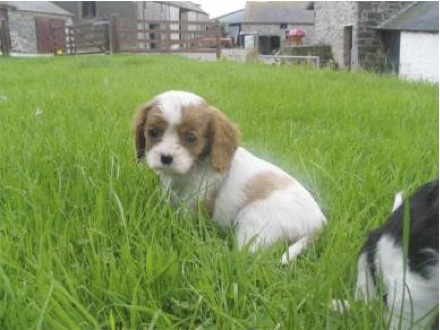
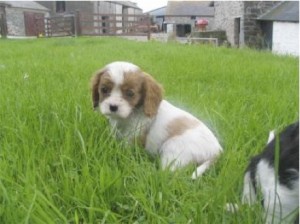

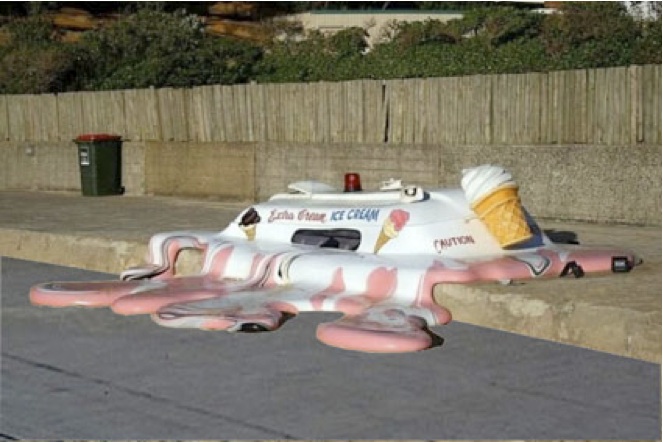

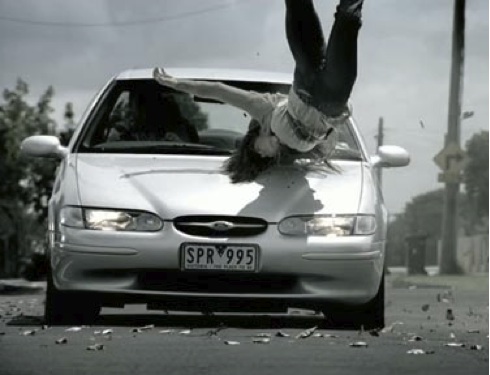
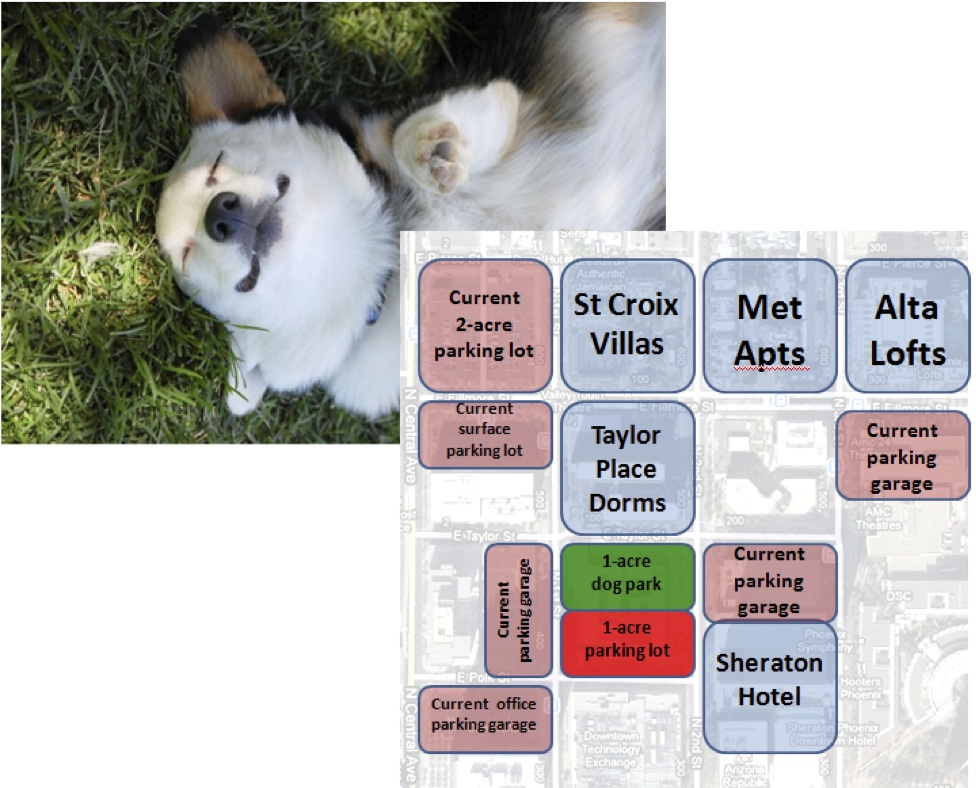





Brilliant step-by-step explanation of your reasoning. I’m a cat person, but I think a dog park would be a better use of this land than 100% allocation to surface parking. I’ll make every effort to be at the November 4 meeting.
I agree a dog park is a good idea, but Civic Space Park doesn’t get used? How does the author figure? Hance Park is of course a wallowing failure, but considering the lack of pedestrians in Downtown in general, Civic Space is a giant success. There are always a variety of people in it at most any time of day or night.
I’d say be careful of possibly coming across like bad mouthing a city project (Civic Space) which is viewed as a success if you want the City to go for something like this.
Also, keep in mind, the key to successful urban parks is: a diversity of uses. A 1 acre dog park sounds rather like a uni-tasker.
Consider the few hundred residents nearest to this parcel are ASU dorm dwellers who are sans dogs. I’d say consider adding amenities for the ASU students.
A boccee ball court doesn’t take much space, & ASU students don’t have anywhere nearby to play volleyball or shoot hoops outside. A boccee ball court, sand volleyball pit & half basketball court would be of minimal cost & vastly increase the parks appeal and use.
I respect your take on things Will – I’ve read some great ideas from you, particularly the roundabout idea on Roosevelt.
I have to disagree about Civic Space Park though. That park was built to look pretty and be event space. Both those things fill a need, and I would never want Civic Space to go away. It will only be used more over time and it will become vibrant in its own way as we grow a pedestrian culture here. Of course, one of the things killing it now is the super block next to it and a lack of pedestrian crossings, making it very hard to access from the West.
It is also not a place conducive to casual interaction with others. One of the reasons it fails there is because someone decided to bury the destinations under the ground (Fair Trade and the other storefronts). Horrible horrible horrible decision.
ASU and some of the students need to start understanding that they are in a community. A downtown college-town is not what anyone wants and will destroy our one true opportunity in the Valley to create a downtown that compares to other cities. ASU and the students need to support the growth of our downtown communities the same way we have supported them by paying for the bonds that gave them the opportunity to be a part of our community. I actually don’t have a dog – the same way they don’t. Yet I see how this type of thing will activate our streets, create a warm interactive community, and bring people together. That is good for everyone – even those without dogs (such as myself and ASU students).
I would support getting other amenities downtown such as boccee ball or volleyball. But those are not things that bring communities together. A dog park directly serves 600 people within walking distance, and indirectly serves every single resident. Those other things are too niche and people don’t say “oh, there’s boccee ball in downtown – therefore it’s easier for me to decide to move away from my Gilbert home w/ a backyard and into downtown Phoenix!”
But if you own a dog, and 39% of Americans do, then a dog park is influential to that decision.
I bring up the Civic Space b/c I just feel that if you say things like “no one uses it” to the City, it’ll hurt your cause more than help.
I respectively strongly disagree with your assertion that sports don’t bring communities together. Sports, both viewing and playing them, brings communities together more than just about anything.
Basketball for instance brings up to 10 people together on the court at once. Not to mention the people waiting for the next game, watching & cheering, etc.
Look at Rucker Park in NYC or street ball courts across the Nation, they’re centers of neighborhood and Civic Pride. Some, like the Rucker even bring national renown.
I don’t have a dog either, but I do have a basketball obsession and nowhere to play downtown. 🙂
I just want to make sure if something terrific like this happens that its not too single use. A park with one use is like a comedian with one joke, it’ll get old real quick.
I like your ideas. We should work together.
A basketball court doesn’t bring together the same diversity of people that a dog park does (it won’t connect an overworked ASU student, a 30 year-old hipster, a 65 year-old widow, and a young professional all together), but I agree that we need that stuff too.
Don’t forget, though, that people are allowed in dog parks, too. A dog park is simply a nice park area that differs in one way from a traditional park: dogs are allowed to run free! Personally I would go there and just read a book, because it would be fun to be around playing dogs 🙂
Ideally, Will, the city would use that whole site for dog park + basketball + volleyball + ______ + ______. No parking at all. Because that would build a community while they wait the decade to secure law school funding. Maybe I’m not being ambitious enough. If ASU students would show up in force against the City’s plan for 90,000 sqft of hot asphalt in their backyard, we could achieve something here.
Do you love dogs, not cars?
Then try to come to the hearing in November (lunchtime, downtown). Here’s the fb invite:
http://www.facebook.com/event.php?eid=169553526395463
Sean and Will,
I agree that almost anything is better than a parking lot, but I believe that the west end of Margaret Hance park is the best place for a dog park.
Look at the dog park in Scottsdale on McDonald as a model of what TO DO, and the one at Steele Indian School as what NOT TO DO.
The one in Scottsdale has two zones for larger dogs so that they can alternative and keep the grass from going dead from dog urine. The area between the Central Ave bridge and 3rd ave is large enough. More importantly, it costs much, much less. It already has sprinklers and it is easy to get to.
They could install a tough, temporary fence that can be taken down during festivals.
I don’t live close to this park, but I see that it is a very dense area, especially to the south. So, it serves quite a few people.
Really, it comes down to what you can get the city to pay for, which is not much at this point.
I’m glad to see this discussion going on, though. I tried to start a dog park MySpace page back in 2007. No luck!
K
We are actually looking into obtaining private sponsors to help the city with maintenance costs.
I considered Hance Park, but the problem with it for a dog park (especially the west side) is that it is not central to downtown and only has dense housing to its south and east. It would be a hike for people from Orpheum, Summit, Stadium Lofts, Artisan Parkview, and even Monroe44 or Alta to a degree. I know lots of people want to find a way to reformat Hance Park, but the dog park is better suited for the center of downtown so that all of our residential can access it – otherwise it will be underutilized.
[…] has outlined his proposal and it is posted on Blooming Rock. You can read it here. If you care about downtown’s vibrancy, pedestrianism, community, or if you want a place for […]
Don’t forget that dog park users don’t just live within walking distance. There are a whole lot of historic homes that are a bit outside walking distance (e.g., Willo, FQ Story, Roosevelt, Palmcroft) that would use this dog park. It would be closer to them than Steele Indian School, which is admittedly a poorly designed dog park. Point being, when selling this to the City, don’t leave out all these households. I’d be remiss if I didn’t mention that these neighborhoods are typically comprised of politically active residents with higher incomes. Not that this should matter, but as things go with the City, this motivates them as much as anything (if not more).
Steve Weiss shared a link to this discussion on Facebook. I’m glad I clicked it. I don’t reside downtown any more but have signed up to attend the meeting.
The City has dumped many hundreds of millions of future tax dollars into both the Sheraton and ASU downtown.
ASU was using the building as temporary dorms – were they renting from the City? and will they rent again when the law school gets built?
In short, I guess, what I don’t know from the thread thus far is, who benefits from the parking lot?
Brilliant Sean! I’m on board.
[…] For a great example of making a (newly) empty lot into a green space, read about Sean Sweat’s proposal for a dog park at the site of the Sahara Hotel in answer to the currently proposed black space […]
[…] Read more Here and Here […]
[…] post is by Sean Sweat who’s posted on Blooming Rock before making a case for a dog park in downtown at the former location of the […]
[…] Dogs, Not Cars December 22, 2010 by phxdowntowner This entry was originally posted at Blooming Rock on Oct 15, 2010: […]